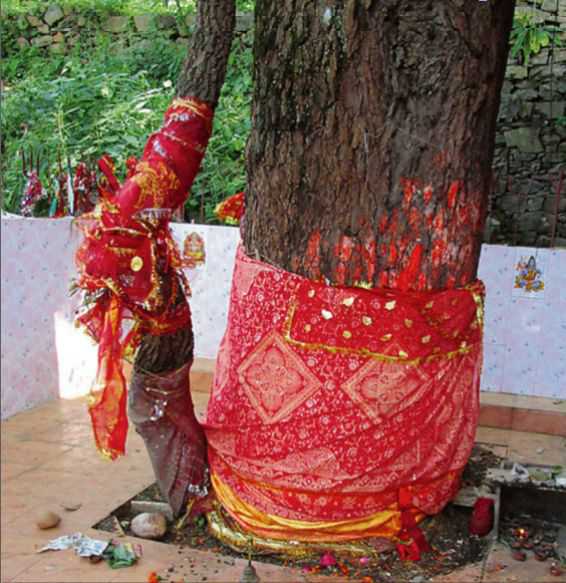Shriniwas Joshi
Ihad recently gone to the Devidhar temple at Kiar Koti, located about 14 km from Shimla city. There is a famous temple of Devi Durga at Kiar village. It attracts thousands of people during Navratras. Adjacent to this temple is another one of Kalyanu Devta built in the ‘Kath-kuni’ style. The temple walls are constructed with alternate courses of dry masonry and wood without any cement mortar in the ‘Kath-kuni’ style. This type of wall construction involves laying two wooden beams longitudinally parallel to each other with a gap in-between. The space between the two members is filled with rubble stone and the edge is secured with ‘kadil’ (wooden nail). The Gazetteer of Simla Hill States–1910 through the words of Pundit Tika Ram Joshi, Rajguru of Keonthal and Koti states, furnishes this information about Kalyanu or Klainu Dev: “The origin of the word Klainu is from ‘Kulu-fa-anu’ meaning brought from Kulu. In Kulu, God is called ‘Jamnu’ from Sanskrit ‘Jamadagni’. It is apparent that the deity is a saint called Dudadhari, meaning a vegetarian. Being vegetarian, he never accepts an animal sacrifice”. It was Jamadagni or Kalyanu, father of Rishi Parsuram, who long ago pronounced that there was a ‘pindi’ of the Devi at the bottom of a deodar tree and it deserved an abode. A temple was constructed where the ‘pindi’ was installed and it is the present day Devidhar temple.
Nobody could tell me the year of its construction but all said, “It was constructed thousands of years ago”. However, the ‘pindi’, when it was tainted for some reasons, had to find shelter for 13 years in the temple of Kalyanu. It was brought back to its original abode in 1963 after following proper Hindu rituals. It was established as Devi Bhagwati. The temple has since been renovated several times and today it has three domes in a row, a rare sight in Himachal Pradesh. The domes are tin-roofed. Those who come to worship the Devi also pay obeisance to the deodar tree where the ‘pindi’ was found. That too is a pious spot in Kiar village and the tree is properly decorated.
After having the darshan of the Devi, devotees also pray before an idol of Bhairav installed outside the temple. It is so in almost all Devi temples. The question is why one has to pray before Bhairav after propitiating the Devi? Even the Vaishno Devi Yatra is considered to be complete only after a visit to the shrine dedicated to Bhairav or Bhairon, which is at a further distance of 2.5 km from the bhawan.
There are two versions given in our legends. One version is that once the devotees of the goddess invited all virgin daughters of the village for Navratra worship. The goddess herself attended the ceremony in the form of a virgin daughter. The villagers had also invited other people of the village for meals and Bhairav was one of them. He got fascinated by the beauty of the goddess in the form of a young and charming girl. Bhairav, somehow, wanted to kidnap the goddess. She ran towards a mountain and did penance in a cave for nine months. Bhairav reached the cave too. Then the Devi took the form of Mahakali and killed him. In his last breath, Bhairav repented his sinful acts and the goddess forgave him and gave him a boon. She proclaimed that no pilgrimage of the goddess will be complete without visiting Bhariav. That is why Bhairav stands outside the temple of Devi Bhagwati and the devotees worship him too.
The other version is that Daksha, father-in-law of Lord Shiva, did not invite him to a ‘havan’ that he had arranged. Sati, wife of Lord Shiva and daughter of Daksha, felt insulted and decided to go to her father’s house to know the reasons for not inviting her husband. Daksha, instead of pacifying her, started abusing Lord Shiva for no particular reasons. Sati could not bear all this and jumped into the ‘havan kund’. Lord Shiva was enraged and he picked up the burning body of Sati and started roaming here and there. He was so angry that he would have destroyed the universe while wandering in the sky carrying the burning body of his wife. Lord Vishnu realised the danger and through a weapon made the pieces of Sati’s body. These pieces fell in different parts of the country. Jwalamukhi and Bajreshwari in Kangra, Naina Devi in Bilaspur and Chintpurni in Una received the tongue, bust, eyes and feet of the Devi, respectively, to establish Shakteepiths there. The spots where the parts of Sati fell became Shaktipiths. It is said that Lord Shiva guards these Shaktipiths in the form of Bhairav. Earlier Bhairav used to stand in Shaktipiths only but now his idol is installed in almost all Devi temples.
Tailpiece
“The simplest and most basic meaning of the symbol of the Goddess is the acknowledgement of the legitimacy of female power as beneficent and independent power.”
— Carol P. Christ
Unlock Exclusive Insights with The Tribune Premium
Take your experience further with Premium access.
Thought-provoking Opinions, Expert Analysis, In-depth Insights and other Member Only Benefits
Already a Member? Sign In Now











